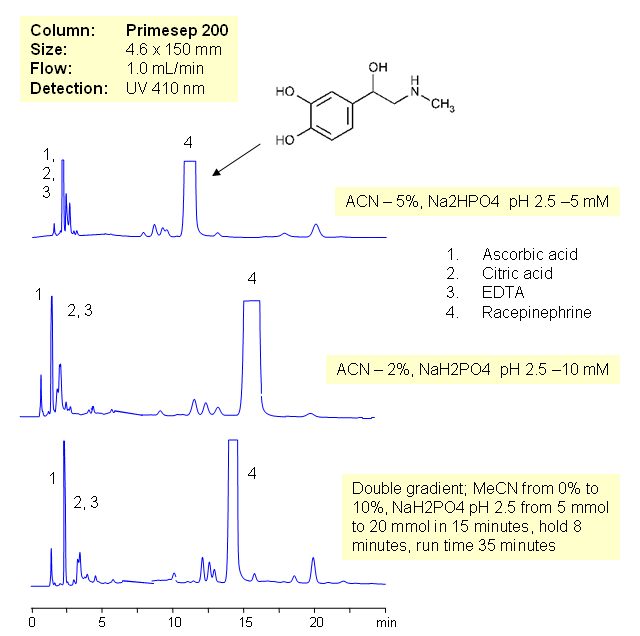
Epinephrine (also referred to as adrenaline) is a hormone and neurotransmitter. It is a catecholamine, a sympathomimetic monoamine derived from the amino acids phenylalanine and tyrosine. Epinephrine is polar basic compounds and it is retained on mixed-mode cation exchange columns without ion-pairing reagent. Epinephrine is retained by weak reversed phase and strong cation-exchange mechanisms. Formulations for epinephrine might have citric and ascorbic acid and EDTA. These three compounds are not retained by cation-exchange or reversed-phase mechanisms and elute in the void. Current HPLC method can be used for quantitation of epinephrine and recepinephrine (recemate) in various compositions. Epinephrine and related impurity can be monitored by UV, ELCD/MS, ELSD or Corona CAD. Corresponding buffer is required for each detection technique.
| Column | Primesep 200, 4.6×150 mm, 5 µm, 100A |
| Mobile Phase | MeCN/H2O |
| Buffer | NaH2PO4 |
| Flow Rate | 1.0 ml/min |
| Detection | 410 |
| Class of Compounds |
Ions, Hydrophilic, Ionizable |
| Analyzing Compounds | Ascorbic acid, Citric acid, EDTA, Racepinephrine |
Application Column
Primesep 200
The Primesep family of mixed-mode columns offers a wide variety of stationary phases, boasting unprecedented selectivity in the separation of a broad array of chemical compounds across multiple applications. Corresponding Primesep guard columns, available with all stationary phases, do not require holders. SIELC provides a method development service available to all customers. Inquire about our specially-tailored custom LC-phases for specific separations.
Select optionsRacepinephrine





